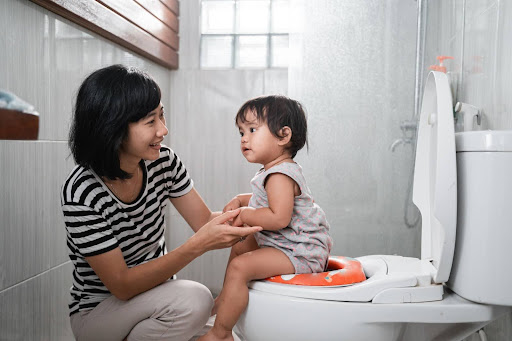Potty training is a significant milestone for both toddlers and parents, marking a transition from diapers to using the toilet independently. While it can be a challenging and sometimes messy process, with patience and a positive approach, parents can guide their children through this developmental stage successfully.
Potty Training Tips
Each child is unique, and there are many different approaches to potty training children. This makes it essential to tailor the approach to your child’s needs and cues and to recognize signs of readiness. Wake Forest Pediatrics has put together some practical tips for effective potty training.
- Timing Is Key
Start potty training when your child shows signs of readiness. Most children are ready between 18 and 24 months, but this can vary. Look for cues such as an increased interest in the bathroom, the ability to communicate basic needs, and the ability to stay dry for longer periods. It is also important to note that boys typically start later and may take longer to train.
- Create A Potty-Friendly Environment
Make the bathroom an inviting and child-friendly space. Use a small potty chair or a child seat on the regular toilet to make it more accessible. You may even consider placing the potty in a more convenient location, such as their bedroom. This gives them access to use it during playtime, or once they awake from naps. Not to mention that it offers their own space and privacy.
- Demonstrate And Encourage
Children learn by example, so allow your child to observe you using the toilet. Use simple language to explain what you are doing, emphasizing that this is what big kids do. Encourage curiosity and interest in the process.
- Establish A Routine
Create a consistent potty routine, such as having your child sit on the potty after meals or before bedtime. Consistency helps children understand the connection between the sensation of needing to go and the act of using the potty.
- Celebrate Small Victories
Praise and positive reinforcement are crucial during potty training. Celebrate each success, no matter how small, with enthusiasm and encouragement. This can be done with a high five, a hug, or small rewards like stickers.
- Be Patient And Understanding
Understand that accidents will happen, and it’s a natural part of the learning process. Instead of getting upset, reassure your child and clean up accidents together. Maintaining a calm and positive attitude helps create a supportive environment for learning.
- Use The Right Tools
Invest in training pants or underwear that your child can easily pull up and down. This promotes independence and makes the transition from diapers smoother. Keep a stash of spare clothes in case of accidents.
- Introduce A Potty Training Schedule
Set a timer for regular potty breaks, especially during the initial stages of training. This proactive approach helps prevent accidents and reinforces the routine. Over time, your child will develop a sense of when they need to go.
- Make It Fun
Turn potty time into a fun and engaging experience. Consider reading books, singing songs, or using interactive apps that focus on potty training. The more enjoyable the process, the more likely your child will be motivated to participate.
- Transition To Nighttime Training Gradually
Nighttime training often takes longer than daytime training. Limit fluid intake before bedtime, encourage your child to use the potty before going to sleep, and consider using training pants or waterproof mattress covers during the transition period.
Potty training is a developmental milestone that requires patience, consistency, and a positive mindset. Here at Wake Forest Pediatrics, our pediatricians are board-certified by the American Board of Pediatrics and members of the American Academy of Pediatrics. Do you have more questions about potty training? Give us a call at 919-556-4779 or request an appointment.




